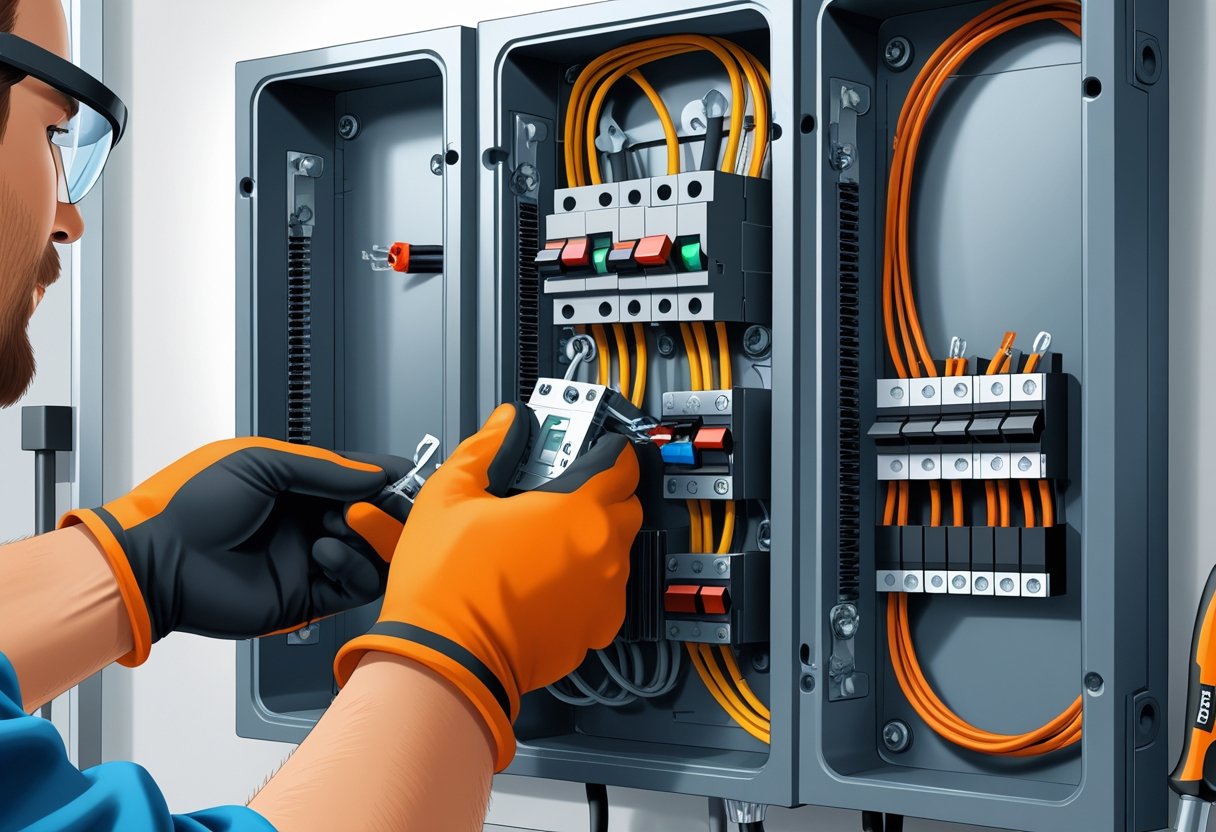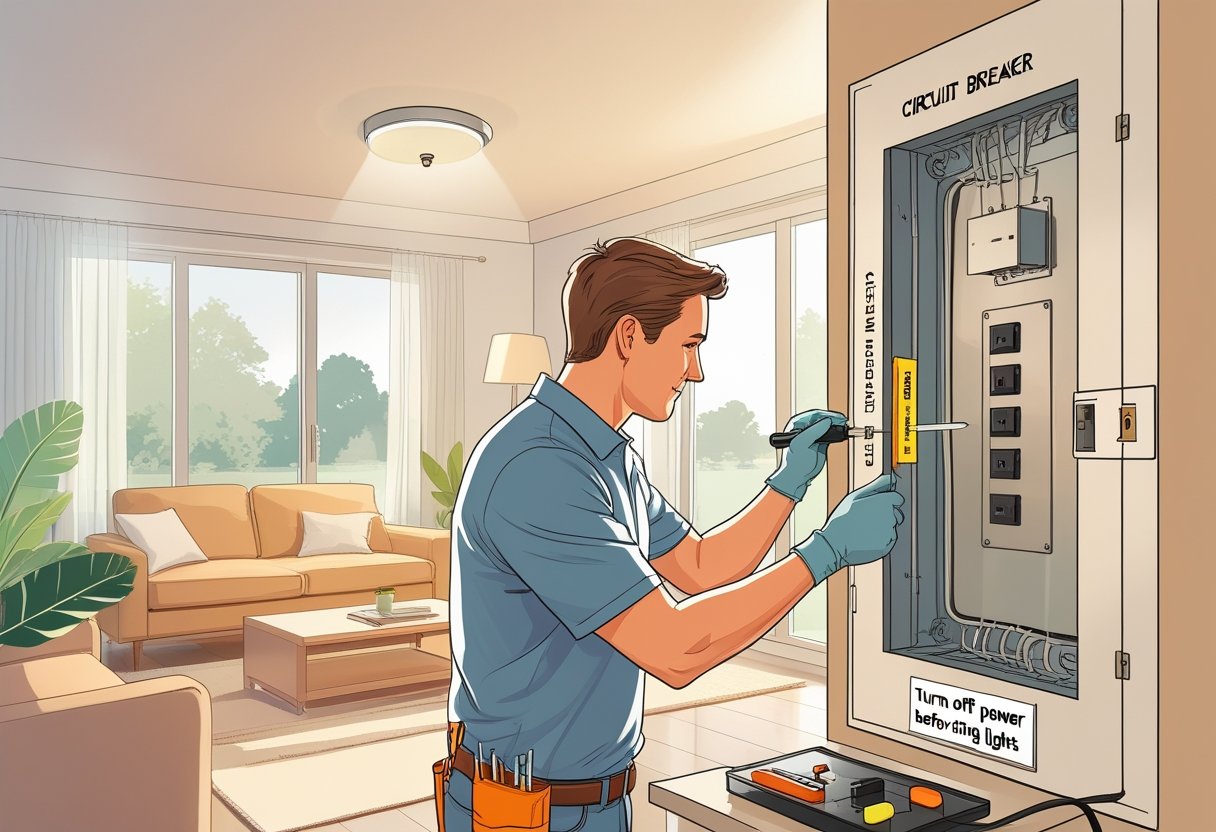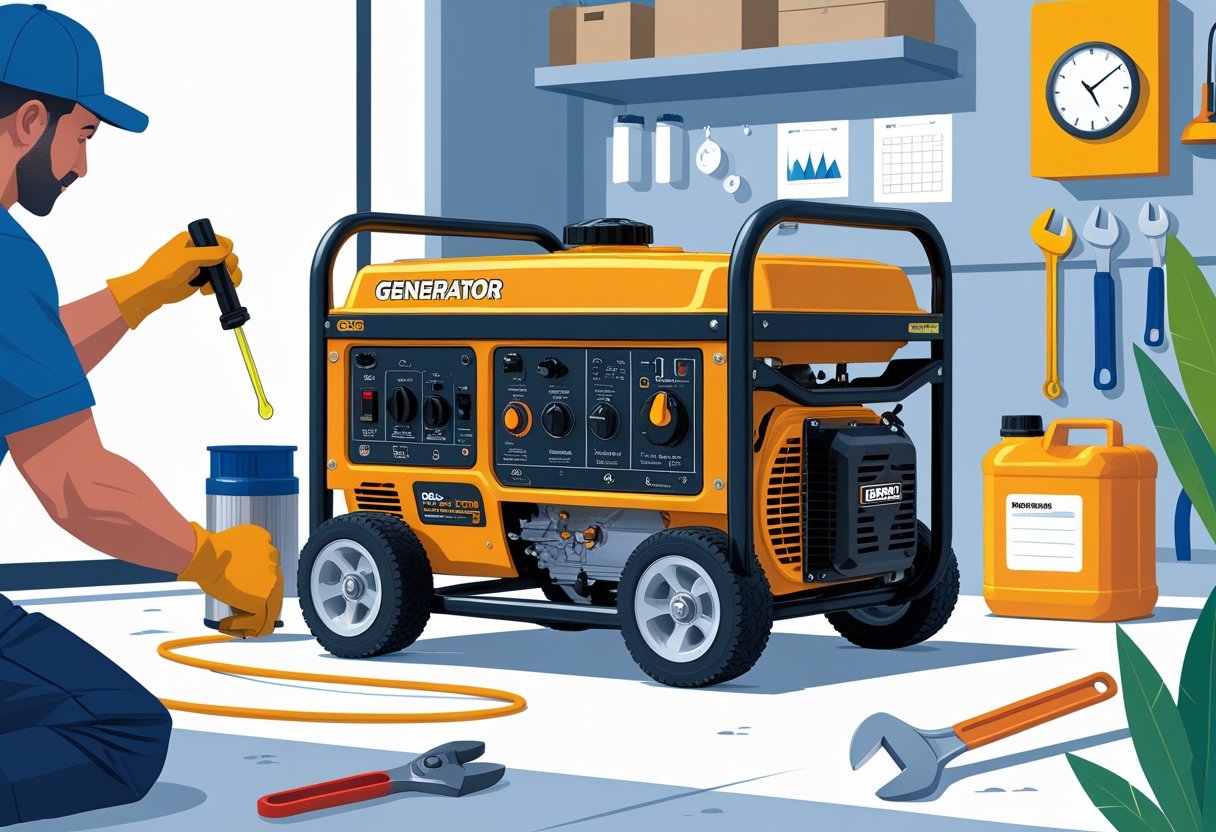If you need to install a new circuit breaker, understanding the process helps ensure your home’s electrical system remains safe and reliable. Installing a new circuit breaker involves turning off power, correctly fitting the breaker into your panel, and securely connecting the wires to prevent hazards. This essential upgrade can protect your home from electrical overloads and keep your family safe.
Choosing the right team for this task is important. AAA Electrical Services offers same-day service with licensed, certified technicians who prioritize safety and clear communication. Serving Sacramento and surrounding areas, they bring over 40 years of experience directly to your home, backed by flat-rate pricing and stocked vans for fast, efficient repairs.
Overview of Circuit Breakers and Electrical Panels
When working with your home's electrical system, understanding the role and structure of circuit breakers and electrical panels is essential. These components manage your power distribution and protect your home from electrical faults, making them critical for your safety and system efficiency.
Purpose and Function of Circuit Breakers
Circuit breakers serve as safety devices that protect your home's wiring from damage caused by overloads or short circuits. They automatically cut off electrical flow when the current exceeds a safe level. This prevents potential fires and damage to appliances.
Each breaker controls power to specific circuits in your home. When a fault occurs, you’ll notice the breaker trips, shutting off power to the affected area. Resetting it restores normal operation, but repeated trips signal a need for inspection or repair.
A double-pole breaker is used for high-demand circuits, like electric ovens or HVAC systems, controlling two hot wires and providing 240 volts of power to heavy appliances.
Components of an Electrical Panel
Your electrical panel is the central hub for power distribution in your home. It houses the main breaker, individual circuit breakers, a bus bar, and grounding components.
- Main breaker: Controls power to the entire panel, allowing you to shut off all power quickly.
- Circuit breakers: Control individual circuits.
- Bus bar: Conducts electricity from the main breaker to each circuit breaker.
- Grounding bar: Provides a safe path for stray electricity.
Panels are designed with specific spaces for circuit breakers, and accommodating new breakers requires free slots and compatibility with the panel’s bus bars.
Types of Circuit Breakers
Circuit breakers vary depending on their function and installation type. Common types include:
- Single-pole breakers: Control 120 volts for lighting and general outlets.
- Double-pole breakers: Control 240 volts for heavy appliances like dryers or ovens.
- Ground Fault Circuit Interrupters (GFCI): Protect against ground faults, commonly installed in bathrooms and kitchens.
- Arc Fault Circuit Interrupters (AFCI): Detect dangerous arcs that can cause fires, required in many living areas.
Choosing the correct breaker type ensures your system meets safety code requirements and handles your home’s load safely.
Breaker Panel Compatibility
Not all circuit breakers fit every electrical panel. Panels are made by specific manufacturers, and breakers must match the panel's brand and model to ensure proper fit and operation.
Installing incompatible breakers can cause loose connections and increased risk of electrical faults. Double-check your panel’s specifications before purchasing breakers.
Upgrading or adding new breakers often involves verifying panel space and making sure the amperage ratings match your system’s requirements. For professional help tailored to your safety and local codes, AAA Electrical Services offers expert circuit breaker installation in Sacramento and nearby areas, ensuring your home’s electrical safety without surprises.
Safety Precautions and Required Tools
Proper preparation is essential when installing a new circuit breaker. You need to understand the risks and have the right tools ready. Careful attention to electrical hazards and personal protection minimizes injury or damage.
Electrical Hazards and Risk Assessment
Working inside your electrical panel exposes you to live wires and potentially dangerous voltages. Always turn off the main power before starting the installation. Use a reliable voltage tester to confirm the power is off before touching any components.
Beware of electrical hazards such as shock, arc flash, or short circuits. Factors to assess include the panel’s condition, space limitations, and your familiarity with electrical systems. If you are unsure, call a professional.
Avoid installation during damp or wet conditions since moisture increases risk. Never bypass safety devices or work without proper clearance inside the panel. These steps reduce the chance of injury or damage to your home’s electrical system.
Personal Protective Equipment
To protect yourself, wear insulated gloves rated for electrical work. These gloves prevent electrical shock and provide a better grip on tools. Always put on safety goggles to shield your eyes from sparks or debris.
Wearing non-conductive footwear and avoiding loose clothing reduces risk. Keeping your work area well-lit and uncluttered supports safer movement and tool handling. Consider wearing a long-sleeve shirt made of natural fibers to avoid burns.
Using proper personal protective equipment (PPE) ensures you stay safe during every stage—including testing, wiring, and securing the breaker. AAA Electrical Services emphasizes safety-first electrical work done by licensed professionals trained to use PPE effectively.
Essential Tools for Circuit Breaker Installation
You will need several key tools to install a circuit breaker safely and correctly:
ToolPurposeVoltage testerVerifies power is offInsulated screwdriversTighten terminals and screwsWire strippersRemove insulation from wiresPliersBend and hold wiresWire cuttersCut cables cleanly
Using insulated or non-conductive tools reduces the risk of shock. Confirm that your replacement breaker matches your panel specifications and local electrical codes.
Keep your workspace organized and have tools within reach to avoid distractions or accidental contacts. If you prefer professional help, AAA Electrical Services offers same-day service with fully stocked vans for fast, safe breaker installation in Sacramento and surrounding areas.
Choosing the Right Circuit Breaker
Selecting a new circuit breaker involves understanding the specific power needs of your home. You must evaluate the amperage required, ensure compatibility with your panel, and confirm available breaker slots to maintain safety and functionality.
Determining Correct Amperage
Choosing the proper amperage is critical to protect your electrical system and avoid overloading. Look for the wire gauge printed on the cable connected to your circuit; this indicates the safe current capacity. For example, 12-gauge wire typically pairs with a 20-amp breaker, while 14-gauge matches a 15-amp breaker.
If the breaker’s amperage rating is too low, it can trip frequently, causing interruptions. Too high, and it risks overheating wires, potentially creating fire hazards. Your new circuit breaker’s amperage should always match your wiring and appliance requirements.
You can consult an electrician, such as the licensed professionals at AAA Electrical Services, who ensure safety-first electrical work done by experts.
Selecting Compatible Breakers
Not all circuit breakers fit all panels. Your new breaker must be compatible in shape, size, and connection type with your bus bar and panel cover. Panels usually accept only specific breaker brands and models to match their bus bar’s design.
Also, consider whether you need a single-pole or double-pole breaker based on your circuit voltage. Single-pole breakers typically handle 120 volts, while double-pole breakers manage 240 volts setups.
A mismatched breaker may not securely connect to the ground bus bar or could cause poor contact, leading to system failure or hazards. Always verify compatibility by checking the panel’s specifications or consulting qualified technicians.
Breaker Slot Availability
Before installation, confirm your breaker panel has an open slot for the new breaker. Crowded panels can force you to upgrade or reorganize breakers. Each panel has a maximum number of breaker slots determined by its design and bus bar arrangement.
Installing a breaker in an incompatible or occupied slot can cause connections to loosen or block airflow, reducing panel efficiency. If your panel is full, a professional from AAA Electrical Services can assist with a panel upgrade or safe breaker reconfiguration.
Checking slot availability ensures a secure connection beneath the panel cover and maintains your electrical system’s integrity.
Step-by-Step Guide to Install a New Circuit Breaker
Installing a new circuit breaker involves careful preparation and attention to detail to ensure your home's electrical system runs safely and efficiently. Key steps include powering down your system, safely accessing the panel, correctly wiring the device, and verifying everything functions properly before reactivating the circuit. Each phase requires focus on safety and precision to protect your family and property.
Turning Off the Power Supply
Start by switching off the main power supply at your electrical panel to eliminate the risk of electrical shock. Locate the main breaker and turn it to the “off” position. Use a voltage tester to confirm the power is off on the panel and the breaker slots you plan to work on.
This step is critical; working with live electricity can cause injury or damage. If you’re unsure how to verify power status safely, contact certified professionals like AAA Electrical Services to assist you. Safety should never be compromised during circuit breaker installation.
Removing the Panel Cover
After ensuring power is completely off, unscrew the panel cover carefully. Keep screws in a safe place as you’ll need them later. Removing the cover exposes the circuit breakers and the wiring inside.
Inspect the panel before proceeding. Identify an empty breaker slot where the new circuit breaker will be installed. Avoid disturbing existing wiring or components unnecessarily. If the panel cover is stubborn or difficult to access, always ask a licensed electrician for help to prevent damage or injury.
Connecting the Hot and Neutral Wires
Identify the hot and neutral wires for the circuit you intend to install. The hot wire usually carries black or red insulation, and it should connect to the new breaker’s terminal. The neutral wire, typically white, must be attached to the neutral bus bar inside the panel.
Strip approximately ½ inch of insulation from the wire ends to ensure a solid connection. Insert wires firmly and tighten the screws securely but avoid over-tightening, which can damage the wire. Using the correct wire gauge for your breaker’s amperage rating is essential for safe operation.
Securing and Testing the New Circuit Breaker
Once wired, snap the new circuit breaker into the empty slot on the panel rail, ensuring it locks firmly. Replace the panel cover and screw it back into place.
Now, restore power by turning on the main breaker. Then switch the new breaker on and test the connected circuit by powering the intended devices or outlets. If the breaker trips immediately, turn it off and check all connections again or consult AAA Electrical Services for a thorough inspection to guarantee your family’s safety.
For detailed instructions on circuit breaker installation and safety, refer to this step-by-step guide to install a circuit breaker.
Professional Help and Regulatory Considerations
Installing a new circuit breaker requires attention to legal standards and technical skill. Proper handling ensures safety and compliance with local electrical codes. Knowing when to engage a licensed electrician and the necessary permits can protect your home and avoid costly mistakes.
When to Hire a Licensed Electrician
If you’re unsure about handling electrical panels or circuit breakers, hiring a licensed electrician is essential. Complex tasks like panel upgrades, replacing faulty breakers, or adding circuits often require specialized knowledge and experience. Mistakes can cause electrical hazards, including fire risks or damage to your home’s wiring.
Licensed professionals, such as those at AAA Electrical Services, bring certified expertise and tools. They follow safety protocols, minimizing risks and ensuring work complies with regulations. If you want peace of mind and safe, reliable results, especially in Sacramento and nearby areas, choosing a professional electrician is your best option.
Code Compliance and Permits
Electrical codes and permit requirements vary by location but always aim to ensure safety and system integrity. When installing a new circuit breaker, you must adhere to the National Electrical Code (NEC) and any local amendments. Failure to comply can lead to failed inspections, fines, or unsafe conditions.
Before starting work, check if your city or county requires a permit. Permits involve inspections to confirm that installations meet safety standards. Licensed electricians typically handle these permit processes on your behalf. This reduces the chance of costly rework and assures your installation passes official review. For residents in Roseville, Rocklin, and surrounding areas, ensuring code compliance is part of the service AAA Electrical Services provides, so you can feel confident in your home's electrical safety.
Frequently Asked Questions
Understanding the specifics of installing a new circuit breaker helps ensure safety and efficiency. Key points include preparing the panel, wiring correctly, handling full breaker panels, and making connections that comply with electrical codes and your home’s needs.
What are the steps to install a circuit breaker for a new outlet?
First, turn off the main power to your breaker panel to prevent electric shock. Remove the panel cover and select an available slot. Connect the circuit breaker to the panel’s bus bar, then run the appropriate gauge wire from the breaker to the new outlet location, securely attaching the wires to the breaker and outlet terminals.
Can you provide a wiring diagram for installing a new circuit breaker?
The typical wiring diagram includes a hot wire connected to the breaker terminal, a neutral wire connected to the neutral bus bar, and a ground wire attached to the grounding bus bar. Ensure the wire gauge matches the breaker rating—usually 12-gauge wire for 20-amp breakers and 14-gauge for 15-amp breakers.
How can you add a new breaker to a panel that is already full?
If your panel has no available slots, you may need a sub-panel or upgrade to a larger panel. Another option is to replace two single-pole breakers with a tandem breaker, if your panel supports it. Consult a licensed professional to evaluate your specific panel and electrical needs.
What is the process for running electrical wire from the breaker box to a new outlet?
Plan the wire path carefully to minimize exposure and avoid damage. Use cable clamps and conduit where required by code. Run the cable from the breaker panel through walls or ceilings, securing it along the route. Strip the wire ends and connect the hot, neutral, and ground wires to the appropriate terminals at both the breaker and outlet.
How do you properly connect a single pole circuit breaker?
Insert the breaker firmly onto the panel’s bus bar slot. Attach the hot wire to the breaker’s screw terminal, making sure the connection is tight. Connect the neutral and ground wires to their respective bus bars. Double-check all connections before restoring power, ensuring no wires are loose or exposed.
What considerations are needed when installing a circuit breaker for an air conditioner?
Air conditioners require breakers rated for the unit’s full-load amperage. Larger units often need double-pole breakers and heavier gauge wire. Verify the manufacturer’s specifications and local codes. Proper breaker sizing and wiring protect the unit and prevent power interruptions.
For professional, safety-first installation in Sacramento and surrounding areas, AAA Electrical Services ensures flat-rate pricing and same-day service by licensed, certified technicians who treat your home with care.





